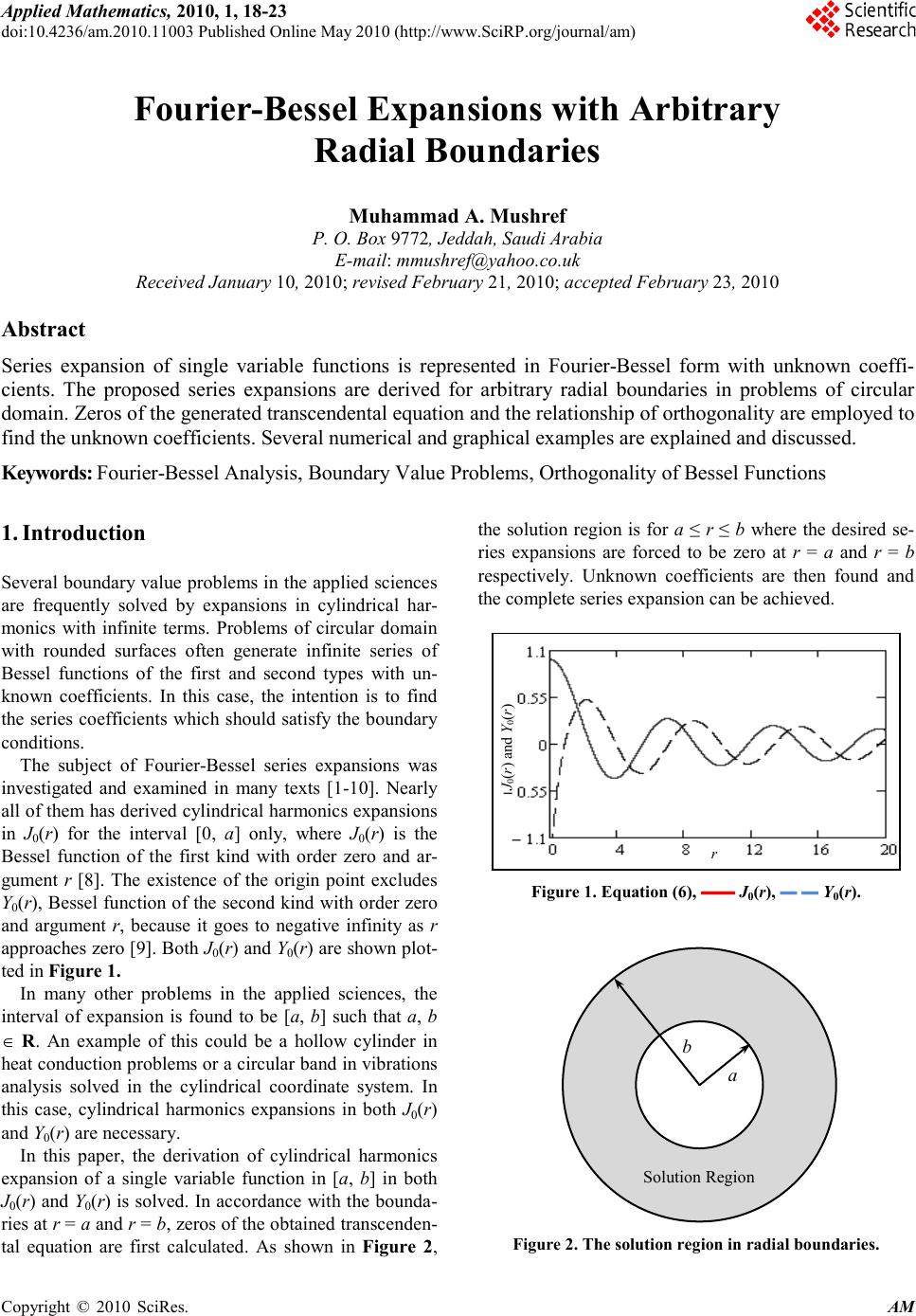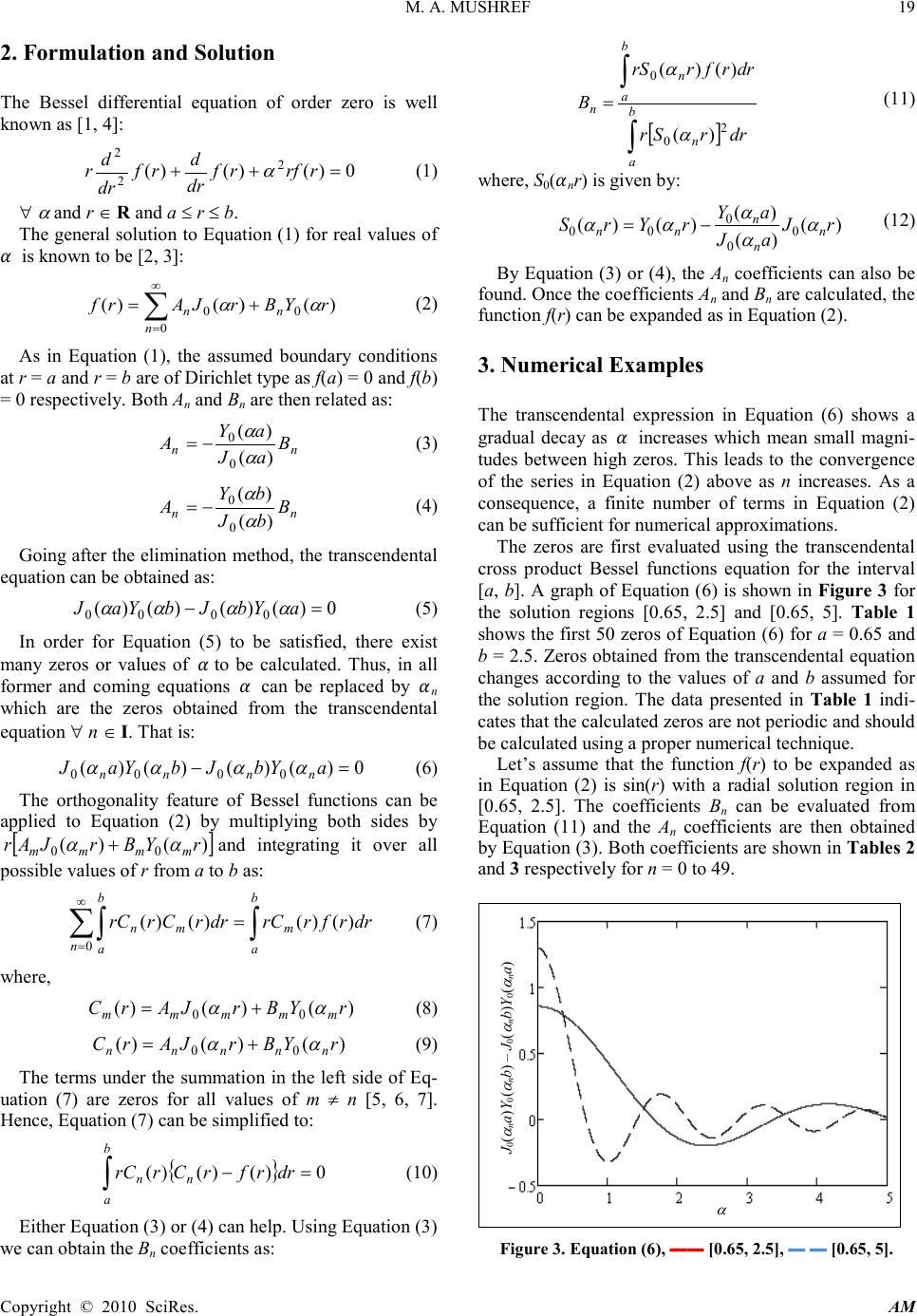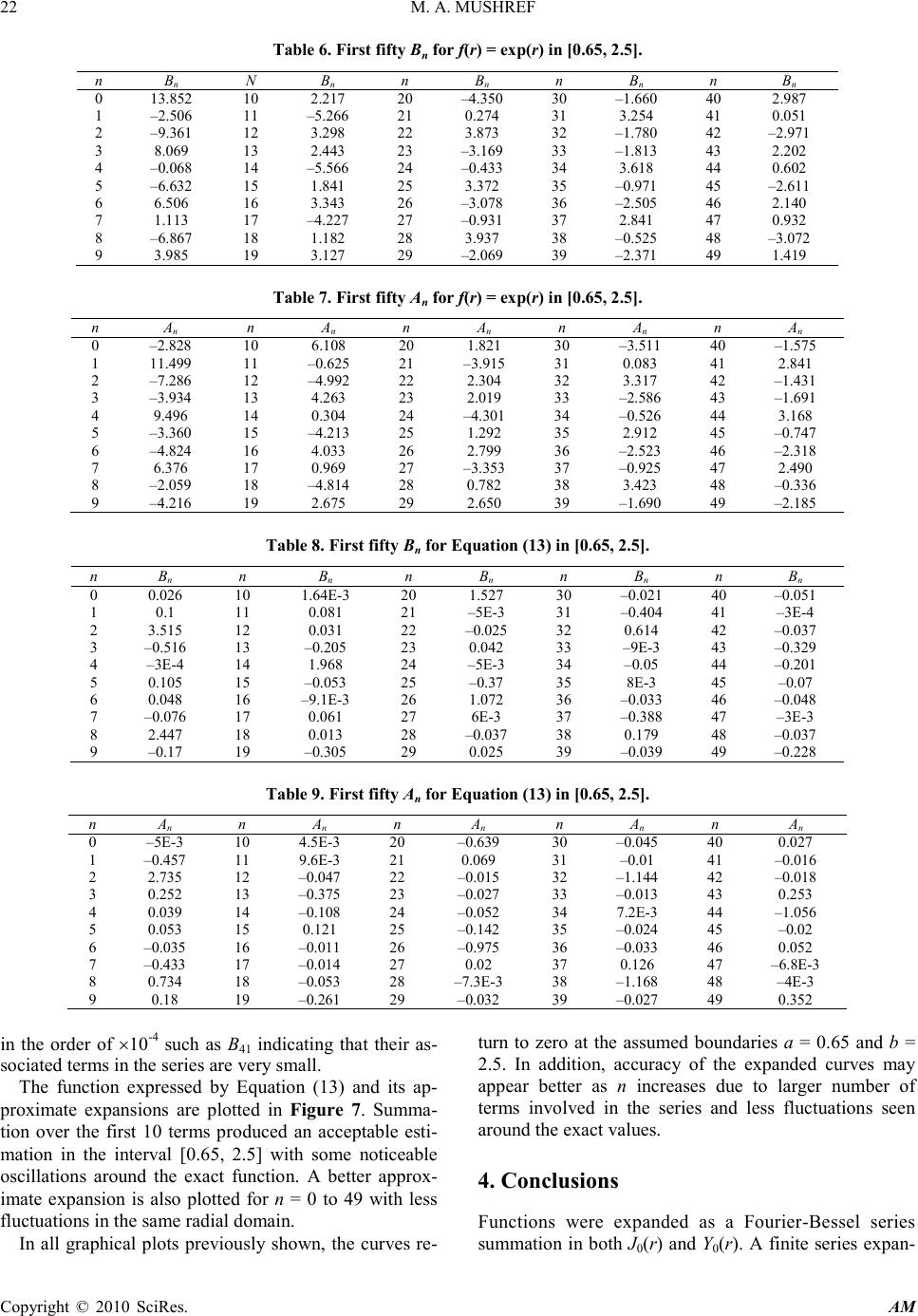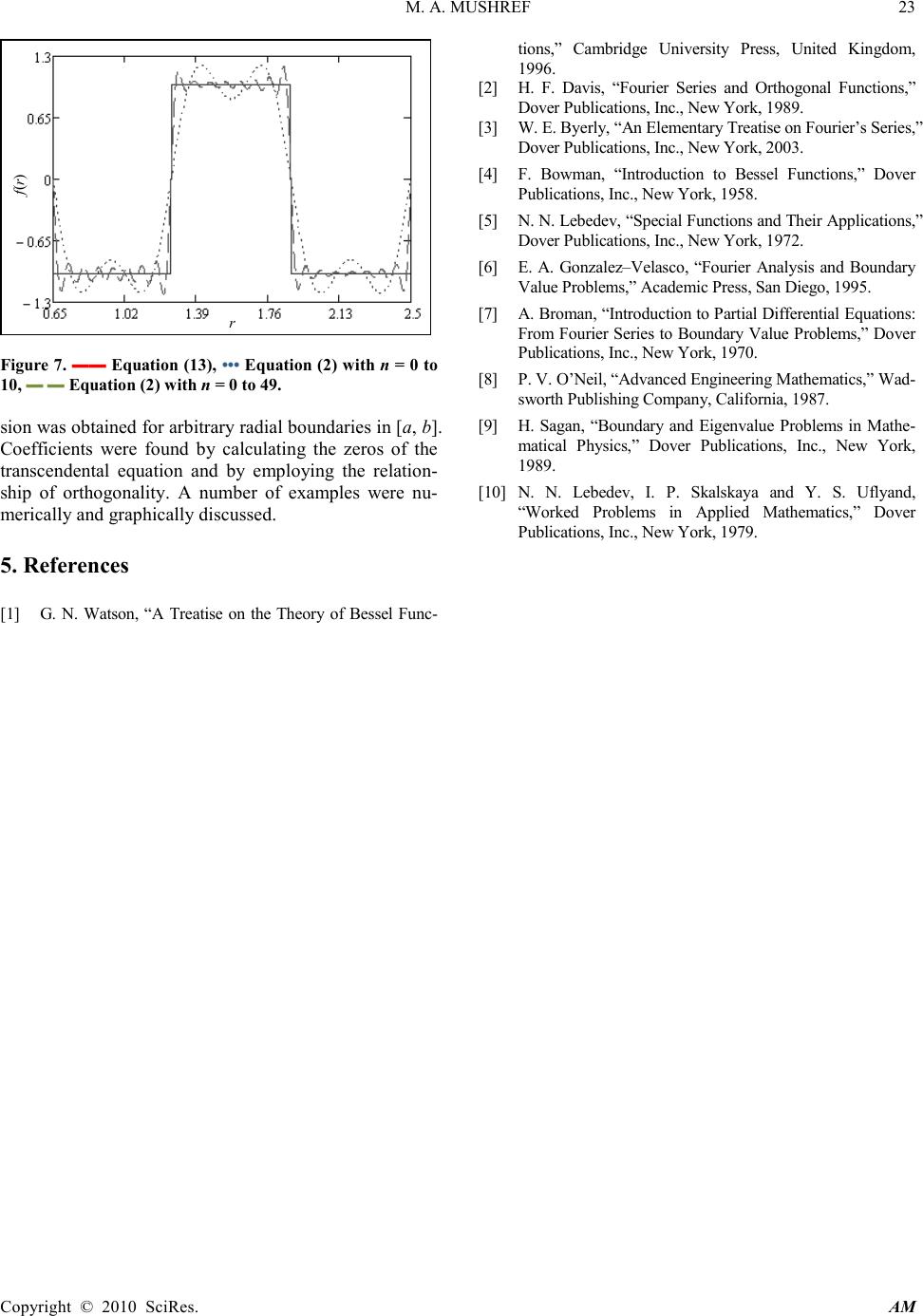Paper Menu >>
Journal Menu >>
 Applied Mathematics, 2010, 1, 18-23 doi:10.4236/am.2010.11003 Published Online May 2010 (http://www.SciRP.org/journal/am) Copyright © 2010 SciRes. AM Fourier-Bessel Expansions with Arbitrary Radial Boundaries Muhammad A. Mush ref P. O. Box 9772, Jeddah, Saudi Arabia E-mail: mmushref@yahoo.co.uk Received January 10, 2010; revised February 21, 2010; accepted February 23, 20 10 Abstract Series expansion of single variable functions is represented in Fourier-Bessel form with unknown coeffi- cients. The proposed series expansions are derived for arbitrary radial boundaries in problems of circular domain. Zeros of the generated transcendental equation and the relationship of orthogonality are employed to find the unknown coefficients. Several numerical and graphical examples are explained and discussed. Keywords: Fourier-Bessel Analysis, Boundary Value Problems, Orthogonality of Bessel Functions 1. Introduction Several boundary value problems in the applied sciences are frequently solved by expansions in cylindrical har- monics with infinite terms. Problems of circular domain with rounded surfaces often generate infinite series of Bessel functions of the first and second types with un- known coefficients. In this case, the intention is to find the series coefficients which should satisfy the boundary conditions. The subject of Fouri er -B esse l series expansions was investigated and examined in many texts [1-10]. Nearly all of them has derived cylindrical harmonics expansions in J0(r) for the interval [0, a] only, where J0(r) is the Bessel function of the first kind with order zero and ar- gument r [8]. The existence of the origin point excludes Y0(r), Bessel function of the second kind with order zero and argument r, because it goes to negative infinity as r approaches zero [9]. Both J0(r) and Y0(r) are shown plot- ted in Figure 1. In many other problems in the applied sciences, the interval of expansion is found to be [a, b] such that a, b ∈ R. An example of this could be a hollow cylinder in heat conduction problems or a circular band in vibrations analysis solved in the cylindrical coordinate system. In this case, cylindrical harmonics expansions in both J0(r) and Y0(r) are necessary. In this paper, the derivation of cylindrical harmonics expansion of a single variable function in [a, b] in both J0(r) and Y0(r) is solved. In accordance with the bounda- ries at r = a and r = b, zeros of the obtained transce nd e n- tal equation are first calculated. As shown in Figure 2, the solution region is for a ≤ r ≤ b where the desired se- ries expansions are forced to be zero at r = a and r = b respectively. Unknown coefficients are then found and the complete series expansion can be achieved. Figure 1. Equation (6), ▬▬ J0(r), ▬ ▬ Y0(r). Figure 2. The solution region in radial boundaries. Solution Region b a r J0(r) and Y0(r)  M. A. MUSHREF 19 Copyright © 2010 SciR es. AM 2. Formulation and Solution The Bessel differential equation of order zero is well known as [1, 4]: 0)()()( 2 2 2 =++ rrfrf dr d rf dr d r α (1) ∀ α and r ∈ R and a ≤ r ≤ b. The general solution to Equation (1) for real values of is known to be [2, 3]: ∑ ∞ = += 0 00 )()()( n nn rYBrJArf αα (2) As in Equation (1), the assumed boundary conditions at r = a and r = b are of Dirichlet type as f(a) = 0 and f(b) = 0 respectively. Both An and Bn are then related as: nn B aJ aY A)( )( 0 0 α α −= (3) nn B bJ bY A)( )( 0 0 α α −= (4) Going after the elimination method, the transcendental equation can be obtained as: 0)()()()( 0000 =− aYbJbYaJ αααα (5) In order for Equation (5) to be satisfied, there exist many zeros or values of to be calculated. Thus, in all former and coming equations can be replaced by n which are the zeros obtained from the transcendental equation ∀ n ∈ I. That is: 0)()()()( 0000 =− aYbJbYaJ nnnn αααα (6) The orthogonality feature of Bessel functions can be applied to Equation (2) by multiplying both sides by [ ] )()( 00 rYBrJAr mmmm αα + and integrating it over all possible values of r from a to b as: ∫ ∑∫ = ∞ = b a m n b a mn drrfrrCdrrCrrC )()()()( 0 (7) where, )()()( 00 rYBrJArC mmmmm αα += (8) )()()( 00 rYBrJArC nnnnn αα += (9) The terms under the summation in the left side of Eq- uation (7) are zeros for all values of m ≠ n [5, 6, 7]. Hence, Equation (7) can be simplified to: { } ∫ =− b a nn drrfrCrrC0)()()( (10) Either Equation (3) or (4) can help. Using Equation (3) we can obtain the Bn coefficients as: [ ] ∫ ∫ = b a n b a n n drrSr drr frrS B 2 0 0 )( )()( α α (11) where, S0(nr) is given by: )( )( )( )()( 0 0 0 00 rJ aJ aY rYrS n n n nn α α α αα −= (12) By Equation (3) or (4), the An coefficients can also be found. Once the coefficients An and Bn are calculated, the function f(r) can be expanded as in Equation (2). 3. Numerical Examples The transcendental expression in Equation (6) shows a gradual decay as increases which mean small magni- tudes between high zeros. This leads to the convergence of the series in Equation (2) above as n increases. As a consequence, a finite number of terms in Equation (2) can be sufficient for numerical approximations. The zeros are first evaluated using the transcendental cross product Bessel functions equation for the interval [a, b]. A graph of Equation (6) is shown in Figure 3 for the solution regions [0.65, 2.5] and [0.65, 5]. Table 1 shows the first 50 zeros of Equation (6) for a = 0.65 and b = 2.5. Zeros obtained from the transcendental equation changes according to the values of a and b assumed for the solution region. The data presented in Table 1 indi- cates that the calculated zeros are not periodic and should be calculated using a proper numerical technique. Let’s assume that the function f(r) to be expanded as in Equation (2) is sin(r) with a radial solution region in [0.65, 2.5]. The coefficients Bn can be evaluated from Equation (11) and the An coefficients are then obtained by Equation (3). Both coefficients are shown in Tables 2 and 3 respectively for n = 0 to 49. Figure 3. Equation (6), ▬▬ [0.65, 2.5], ▬ ▬ [0.65, 5]. J0( α na)Y0( α nb) – J0( α nb)Y0( α na) α  20 M. A. MUSHREF Copyright © 2010 SciR es. AM Many variations can be noticed for the numerical val- ues of An and Bn with a general absolute scale of < 1 ex- cept for B0 = 2.328. Some coefficients are in the order of ×10-3 meaning that their associated terms are very small such as B4 and A31 in Tables 2 and 3 respectively. The function sin(r) and its approximate expansions are plotted in Figure 4. Summation over the first 10 terms produced an acceptable estimation in the interval [0.65, 2.5] with some apparent oscillations around the exact function. An improved approximate expansion is also plotted for n = 0 to 49 with less fluctuations in the same radial domain. Table 1. First fifty zeros of Equation (6) in [0.65, 2.5]. n α n n α n n α n n α n n α n 0 1 2 3 4 5 6 7 8 9 1.663 3.376 5.08 6.782 8.4815 10.182 11.881 13.579 15.279 16.977 10 11 12 13 14 15 16 17 18 19 18.676 20.374 22.073 23.771 25.47 27.168 28.866 30.564 32.263 33.961 20 21 22 23 24 25 26 27 28 29 35.659 37.358 39.056 40.754 42.452 44.151 45.849 47.547 49.245 50.943 30 31 32 33 34 35 36 37 38 39 52.642 54.34 56.038 57.736 59.434 61.133 62.831 64.529 66.227 67.925 40 41 42 43 44 45 46 47 48 49 69.624 71.322 73.02 74.718 76.416 78.115 79.813 81.511 83.209 84.907 Table 2. First fifty Bn for f(r) = sin(r) in [0.65, 2.5]. n B n n B n n B n n B n n B n 0 1 2 3 4 5 6 7 8 9 2.328 –0.101 –0.703 0.234 –4.8E-3 –0.181 0.455 0.030 –0.478 0.105 10 11 12 13 14 15 16 17 18 19 0.154 –0.138 0.228 0.064 –0.385 0.048 0.231 –0.110 0.082 0.081 20 21 22 23 24 25 26 27 28 29 –0.300 7.1E-3 0.267 –0.082 –0.030 0.087 –0.212 –0.024 0.272 –0.054 30 31 32 33 34 35 36 37 38 39 –0.114 0.084 –0.123 –0.047 0.250 –0.025 –0.173 0.074 –0.036 –0.061 40 41 42 43 44 45 46 47 48 49 0.206 1.3E-3 –0.205 0.057 0.042 –0.068 0.148 0.024 –0.212 0.037 Table 3. First fifty An for f(r) = sin(r) in [0.65, 2.5]. n A n n A n n A n n A n n A n 0 1 2 3 4 5 6 7 8 9 –0.475 0.462 –0.547 –0.114 0.675 –0.092 –0.338 0.170 –0.143 –0.111 10 11 12 13 14 15 16 17 18 19 0.424 –0.016 –0.346 0.111 0.021 –0.110 0.279 0.025 –0.333 0.070 20 21 22 23 24 25 26 27 28 29 0.126 –0.102 0.159 0.052 –0.297 0.034 0.193 –0.087 0.054 0.069 30 31 32 33 34 35 36 37 38 39 –0.242 2.1E-3 0.229 –0.067 –0.036 0.075 –0.174 –0.024 0.236 –0.044 40 41 42 43 44 45 46 47 48 49 –0.109 0.074 –0.099 –0.044 0.218 –0.019 –0.160 0.064 –0.023 –0.057 Table 4. First fifty Bn for f(r) = cos(r) in [0.65, 2.5]. n Bn n Bn n Bn n Bn n Bn 0 1 2 3 4 5 6 7 8 9 –0.129 0.338 0.286 –0.919 2.0E-3 0.732 –0.196 –0.122 0.207 –0.433 10 11 12 13 14 15 16 17 18 19 –0.067 0.571 –0.099 –0.264 0.167 –0.199 –0.100 0.457 –0.036 –0.338 20 21 22 23 24 25 26 27 28 29 0.131 –0.030 –0.116 0.342 0.013 –0.364 0.092 0.100 –0.118 0.223 30 31 32 33 34 35 36 37 38 39 0.050 –0.351 0.053 0.195 –0.109 0.105 0.075 –0.306 0.016 0.256 40 41 42 43 44 45 46 47 48 49 –0.090 –5.5E-3 0.089 –0.237 –0.018 0.281 –0.064 –0.100 0.092 –0.153 In addition, f(r) = cos(r) is expanded as in Equation (2) and the first fifty coefficients are listed in Tables 4 and 5 for the Bn and An respectively. Similar to the sin(r), the cos(r) coefficients go through several variations with a general absolute scale of < 1 except A1 = −1.550. Also, only four coefficients are in the order of ×10-3 implying that their related terms in the series are extremely small such as B4 and A41 in Tables 4 and 5 respectively.  M. A. MUSHREF 21 Copyright © 2010 SciRes. AM Table 5. First fifty An for f(r) = cos(r) in [0.65, 2.5]. n A n n A n n A n n A n n A n 0 1 2 3 4 5 6 7 8 9 0.026 –1.550 0.222 0.448 –0.287 0.371 0.145 –0.696 0.062 0.458 10 11 12 13 14 15 16 17 18 19 –0.184 0.068 0.150 –0.461 –9.1E-3 0.455 –0.121 –0.105 0.145 –0.289 20 21 22 23 24 25 26 27 28 29 –0.055 0.422 –0.069 –0.218 0.129 –0.139 –0.084 0.362 –0.023 –0.286 30 31 32 33 34 35 36 37 38 39 0.105 –8.9E-3 –0.100 0.279 0.016 –0.314 0.076 0.100 –0.103 0.182 40 41 42 43 44 45 46 47 48 49 0.047 –0.306 0.043 0.182 –0.095 0.080 0.070 –0.268 0.010 0.235 Figure 4. ▬▬ s i n(r), ••• Equation (2) with n = 0 to 10, ▬ ▬ Equation (2) with n = 0 to 49. Figure 5. ▬▬ cos(r), ••• Equation (2) with n = 0 to 10, ▬ ▬ Equation (2) with n = 0 to 49. The function cos(r) and its estimated expansions are shown plotted in Figure 5. Finite summation over the first 10 terms generated a satisfactory estimation in the interval [0.65, 2.5] with several obvious oscillations close to the exact function. A better approximate expan- sion is also plotted for n = 0 to 49 with less fluctuations in the same solution region. The calculated coefficients for the function er are also shown in Tables 6 and 7 for Bn and An respectively. Ap- parently, the coefficients swing around the exact values with an absolute level of > 1 or < 1. The greatest values in Tables 6 and 7 are found as B0 = 13.852 and A1 = 11.499. In addition, no coefficients are calculated in the order of ×10-3 implying that all coeffi- cients are to be included in the series expansion. The function exp(r) and its estimated expansions are shown plotted in Figure 6 in [0.65, 2.5]. A satisfactory estimation of a finite summation over the first 10 terms are generated with several oscillations close to the exact function. A good approximated expansion is also plotted for n = 0 to 49 with fewer variations in the same solution regio n. The last numerical example to be discussed is the square function expressed as: − ≤≤ =otherwise r rf 1 88.126.11 )( (13) The calculated Bn and An coefficients for this function are shown in Tables 8 and 9 respectively. Similar to former expansions, both coefficients vary about the exact values of Equation (13). The Bn coefficients have a general ab- solute level of < 1 except B2, B8, B14, B20 and B26 that have an absolute scale of > 1. Furthermore, the An coef- ficients show an absolute level of < 1 except the absolute values of A2, A32, A38 and A44 that are > 1. Some Bn and An coefficients are calculated in the order of ×10-3 like A0 or Figure 6. ▬▬ exp(r), ••• Equation (2) with n = 0 to 10, ▬ ▬ Equation (2) with n = 0 to 49. cos(r) r sin(r) r exp(r) r  22 M. A. MUSHREF Copyright © 2010 SciRes. AM Table 6. First fifty Bn for f(r) = exp( r) in [0.65, 2.5]. n B n N B n n B n n B n n B n 0 1 2 3 4 5 6 7 8 9 13.852 –2.506 –9.361 8.069 –0.068 –6.632 6.506 1.113 –6.867 3.985 10 11 12 13 14 15 16 17 18 19 2.217 –5.266 3.298 2.443 –5.566 1.841 3.343 –4.227 1.182 3.127 20 21 22 23 24 25 26 27 28 29 –4.350 0.274 3.873 –3.169 –0.433 3.372 –3.078 –0.931 3.937 –2.069 30 31 32 33 34 35 36 37 38 39 –1.660 3.254 –1.780 –1.813 3.618 –0.971 –2.505 2.841 –0.525 –2.371 40 41 42 43 44 45 46 47 48 49 2.987 0.051 –2.971 2.202 0.602 –2.611 2.140 0.932 –3.072 1.419 Table 7. First fifty An for f(r) = exp( r) in [0.65, 2.5]. n A n n A n n A n n A n n A n 0 1 2 3 4 5 6 7 8 9 –2.828 11.499 –7.286 –3.934 9.496 –3.360 –4.824 6.376 –2.059 –4.216 10 11 12 13 14 15 16 17 18 19 6.108 –0.625 –4.992 4.263 0.304 –4.213 4.033 0.969 –4.814 2.675 20 21 22 23 24 25 26 27 28 29 1.821 –3.915 2.304 2.019 –4.301 1.292 2.799 –3.353 0.782 2.650 30 31 32 33 34 35 36 37 38 39 –3.511 0.083 3.317 –2.586 –0.526 2.912 –2.523 –0.925 3.423 –1.690 40 41 42 43 44 45 46 47 48 49 –1.575 2.841 –1.431 –1.691 3.168 –0.747 –2.318 2.490 –0.336 –2.185 Table 8. First fifty Bn for Equation (13) in [0.65, 2.5]. n Bn n Bn n Bn n Bn n Bn 0 1 2 3 4 5 6 7 8 9 0.026 0.1 3.515 –0.516 –3E-4 0.105 0.048 –0.076 2.447 –0.17 10 11 12 13 14 15 16 17 18 19 1.64E-3 0.081 0.031 –0.205 1.968 –0.053 –9.1E-3 0.061 0.013 –0.305 20 21 22 23 24 25 26 27 28 29 1.527 –5E-3 –0.025 0.042 –5E-3 –0.37 1.072 6E-3 –0.037 0.025 30 31 32 33 34 35 36 37 38 39 –0.021 –0.404 0.614 –9E-3 –0.05 8E-3 –0.033 –0.388 0.179 –0.039 40 41 42 43 44 45 46 47 48 49 –0.051 –3E-4 –0.037 –0.329 –0.201 –0.07 –0.048 –3E-3 –0.037 –0.228 Table 9. First fifty An for Equation (13) in [0.65, 2.5]. n An n An n An n An n An 0 1 2 3 4 5 6 7 8 9 –5E-3 –0.457 2.735 0.252 0.039 0.053 –0.035 –0.433 0.734 0.18 10 11 12 13 14 15 16 17 18 19 4.5E-3 9.6E-3 –0.047 –0.375 –0.108 0.121 –0.011 –0.014 –0.053 –0.261 20 21 22 23 24 25 26 27 28 29 –0.639 0.069 –0.015 –0.027 –0.052 –0.142 –0.975 0.02 –7.3E-3 –0.032 30 31 32 33 34 35 36 37 38 39 –0.045 –0.01 –1.144 –0.013 7.2E-3 –0.024 –0.033 0.126 –1.168 –0.027 40 41 42 43 44 45 46 47 48 49 0.027 –0.016 –0.018 0.253 –1.056 –0.02 0.052 –6.8E-3 –4E-3 0.352 in the order of ×10-4 such as B41 indicating that their as- sociated terms in the series are very small. The function expressed by Equation (13) and its ap- proximate expansions are plotted in Figure 7. Summa- tion over the first 10 terms produced an acceptable esti- mation in the interval [0.65, 2.5] with some noticeable oscillations around the exact function. A better approx- imate expansion is also plotted for n = 0 to 49 with less fluctuations in the same radial domain. In all graphical plots previously shown, the curves re- turn to zero at the assumed boundaries a = 0.65 and b = 2.5. In addition, accuracy of the expanded curves may appear better as n increases due to larger number of terms involved in the series and less fluctuations seen around the exact values. 4. Conclusions Functions were expanded as a Fourie r-Bessel ser ie s summation in both J0(r) and Y0(r). A finite series expan-  M. A. MUSHREF 23 Copyright © 2010 SciR es. AM Figure 7. ▬▬ Equation (13), ••• Equation (2) with n = 0 to 10, ▬ ▬ Equation (2) with n = 0 to 49. sion was obtained for arbitrary radial boundaries in [a, b]. Coefficients were found by calculating the zeros of the transcendental equation and by employing the relation- ship of orthogonality. A number of examples were nu- merically and graphically discussed. 5. References [1] G. N. Watson, “A Treatise on the Theory of Bessel Func- tions,” Cambridge University Press, United Kingdom, 1996. [2] H. F. Davis, “Fourier Series and Orthogonal Functions,” Dover Publications, Inc., New York, 1989. [3] W. E. Byerly, “An Elementary Treatise on Fourier’s Series,” Dover Publications, Inc., New York, 2003. [4] F. Bowman, “Introduction to Bessel Functions,” Dover Publications, Inc., New York, 1958. [5] N. N. Lebedev, “Special Functions and Their Applications,” Dover Publications, Inc., New York, 1972. [6] E. A. Gonzalez–Velasco, “Fourier Analysis and Boundary Value Problems,” Academic Press, San Diego, 1995. [7] A. Broman, “Introduction to Partial Differential Equations: From Fourier Series to Boundary Value Problems,” Dover Publications, Inc., New York, 1970. [8] P. V. O’Neil, “Advanced Engineering Mathematics,” Wad- sworth Publishing Company, California, 1987. [9] H. Sagan, “Boundary and Eigenvalue Problems in Mathe- matical Physics,” Dover Publications, Inc., New York, 1989. [10] N. N. Lebedev, I. P. Skalskaya and Y. S. Uflyand, “Worked Problems in Applied Mathematics,” Dover Publications, Inc., New York, 1979. r f(r) |

